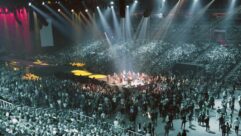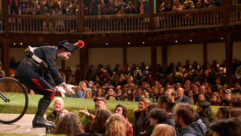

Johannesburg, South Africa – January 2014… A
Acclaimed South African-born artist William Kentridge has a well-deserved reputation for the unusual. His work spans the audio and visual spectrum, from drawings and prints to operas and charcoal drawn animations. In his latest installation, “The Refusal of Time,” Kentridge fuses sculpture with digital video and complex, multi-layered soundscapes to create a multimedia work that is both powerful and compelling.
The viewer is immersed with five video screens covering three walls, running separate but interwoven program material accompanied by a multi-channel music and sound sculpture. There is a sculpture of a man holding a big megaphone, as well as a giant wooden, breathing elephant in the middle of the room, making reference to Charles Dickens’ Industrial Revolution. The soundtrack includes music composed by Philip Miller, as well as spoken word, including Kentridge’s own voice from the megaphone, and of course, the elephant’s breathing. The end result is a clearly unique and intricate audio/visual installation.

The man charged with the logistics of running this complex and unusual setup is engineer/sound designer Gavan Eckhart. With an installation requiring sophisticated mixing and matrixing and powerful signal processing, Eckhart chose theA
A as the central audio hub.
A four-channel bed of music forms the sonic foundation, blending samples of African languages and chants atop Miller’s orchestral array of trumpet, trombone, tuba, grand piano, and various percussion. The quadraphonic surround mix is sent, via four of the AudioBox 1818VSL’s outputs, to four JBL Eon powered monitors.
On top of this mix is Kentridge’s spoken-word soundscape: the man with the megaphone. Here, Eckhart had to think of a creative way to achieve just the right metallic, low-fi sound. “The megaphones are a big component of the whole piece,” he says. “I came up with the idea to just grab some car speakers and mount them in tin cones on tripods and see if it worked. Fortunately, it did. That low-quality rattle and hum those cones produce is actually part of the beauty of the piece.” Four more outputs from the AudioBox 1818VSL feed the car speakers via a four-channel amplifier.

The installation includes a total of seven Mac minis: five running video playout, a sixth running the audio, and one more as master controller. With most of the installations residing in large warehouse spaces, it’s easy to imagine the potential for things to degenerate into a muddy-sounding cacophony. But Eckhart says the AudioBox 1818VSL is more than up to the task.
“The AudioBox 1818VSL gives me enough matrixing and discrete outputs to route all the individual signals,” he says. “But more than that, it has a nice, well-defined sound that really allows me to get a good separation between the beautiful musical backdrop and the spoken word with these distorted car speakers.”
The AudioBox 1818VSL’s onboard signal processing helps to further define and refine the mix, says Eckhart. “I find that the EQs are very useful for shaping the sound and achieving separation. If it’s a very bass-heavy room, I can just roll off a bit of lows or bring a bit of sparkle to the speakers instead of having to remix and re-export it. It lessens the processing demands on the computer and gives me a tremendous amount of control to create a clear and well-defined soundscape.”
Since its debut at the Dokumenta 13 festival in Kassel, Kentridge’s “The Refusal of Time” has been installed at numerous museums worldwide, including Rome, Paris, and Eindhoven, with new installations scheduled in Germany, Japan, Australia, and the United States.
###










